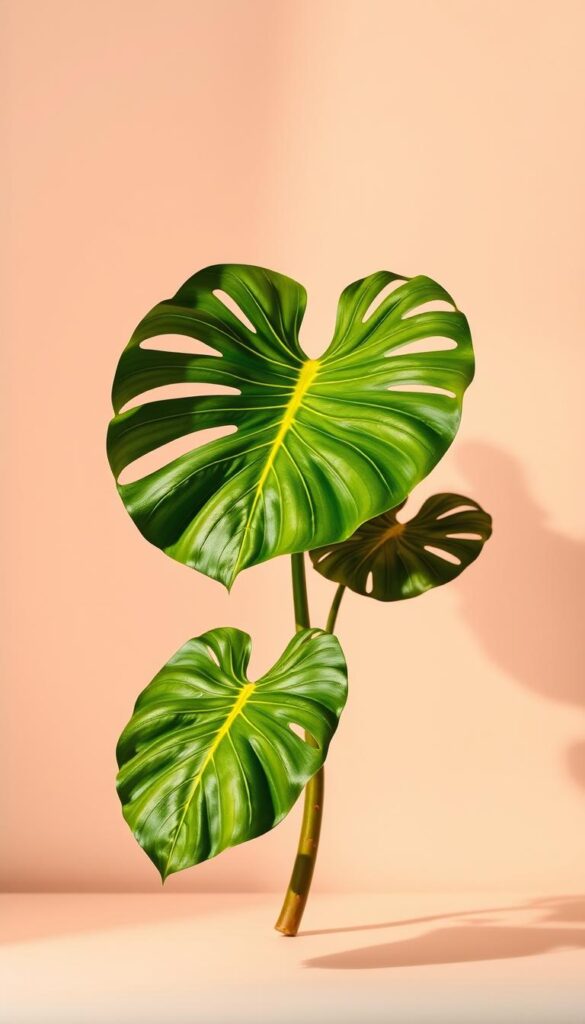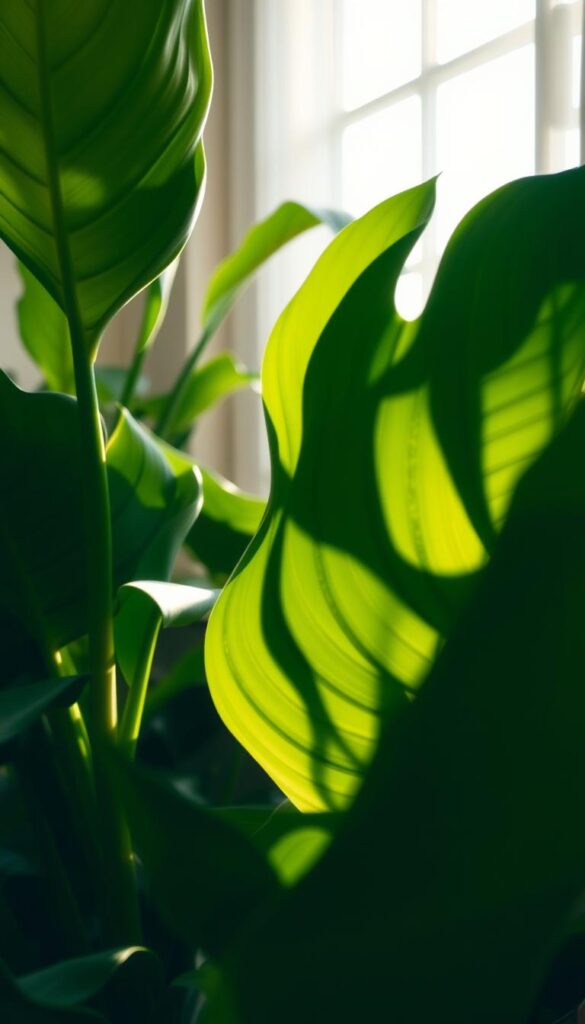Like many plant enthusiasts, I’ve fallen in love with the stunning Monstera deliciosa. Its fenestrated leaves are a true marvel of nature, turning any room into a lush oasis. But I quickly learned that giving my Monstera the right light is crucial for its health and beauty.
Monsteras thrive in bright, indirect light, just like they do in their tropical habitats. Proper light isn’t just about aesthetics; it’s essential for photosynthesis and those iconic leaves. Through research and trial, I discovered the perfect balance for my plant.
Keeping my Monstera near an east-, south-, or west-facing window provides the ideal conditions. I’ll share practical tips and insights on how to create the best environment for your plant, from understanding light needs to seasonal adjustments.
Key Takeaways
- Monsteras need bright, indirect light for optimal growth and fenestrated leaves.
- Place your plant near east-, south-, or west-facing windows for ideal light conditions.
- Proper light balance is essential for photosynthesis and overall plant health.
- Research and trial help determine the perfect light conditions for your Monstera.
- Seasonal adjustments may be necessary to maintain optimal light exposure.
Understanding monstera light requirements
As a plant lover, I’ve discovered the unique charm of the Monstera deliciosa. Its fenestrated leaves add a touch of tropical beauty to any room, but I soon realized that providing the right light is essential for its health and appearance.
Why Light is Key to My Monstera’s Growth
Proper light isn’t just about aesthetics; it’s vital for photosynthesis and those iconic fenestrated leaves. I’ve noticed that when my Monstera gets the right amount of bright, indirect light, it thrives, producing more leaves and healthier growth.
Key Observations:
- Shifting from low light to bright, indirect light can significantly boost growth and fenestration.
- Consistent exposure to 5-8 hours of filtered sunlight helps prevent leggy stems.
- Monitoring water usage is crucial; the soil shouldn’t retain too much moisture.
The plant’s color and split leaves are indicators of sufficient light. Understanding the difference between direct and indirect light has been key. While direct sunlight can be harsh, bright indirect light provides the perfect balance.
Lighting Conditions Comparison
| Light Type | Effect on Plant | Recommended Duration |
|---|---|---|
| Bright Indirect Light | Healthy growth, fenestrated leaves | 5-8 hours |
| Direct Sunlight | May cause stress or discoloration | Avoid prolonged exposure |
| Low Light | Slower growth, fewer fenestrations | Not recommended |
If signs of insufficient light appear, repositioning the plant can make a significant difference. Ensuring the right light condition is a simple yet effective way to support your Monstera’s overall health and beauty.
Creating the Ideal Light Environment
When it comes to giving my Monstera the perfect light setup, I’ve learned that it’s all about observation and a little trial and error. Understanding how light moves through my space throughout the day has been key to creating the right conditions for my plant.
Evaluating Window Orientation and Exposure
I start by checking the direction my windows face. East- and west-facing windows offer gentle morning and afternoon light, while south-facing windows get direct sunlight throughout the day. I’ve noticed that placing my Monstera near an east- or west-facing window provides the ideal bright, indirect light it loves.
Indirect vs. Direct Light for Healthy Leaves
While direct sunlight can be too harsh and cause leaves to become discolored, indirect light fosters healthy growth and beautiful fenestration. To avoid direct sun, I use sheer curtains or move my plant a few feet away from the window. Even small adjustments can make a big difference in promoting new growth and holey leaves.
By carefully evaluating window orientation and light quality, I ensure my Monstera gets the perfect balance of light for thriving, split leaves and robust growth.
Recognizing My Monstera’s Light Signs
Over time, I’ve learned to pay attention to how my Monstera responds to light. It’s amazing how this plant communicates through its leaves and growth patterns. By noticing these signals, I can adjust its environment to ensure it stays healthy and thrives.
Symptoms of Insufficient Light
If my Monstera isn’t getting enough light, I notice a few telltale signs. The leaves might turn yellow or stay solid without any splits. Growth tends to slow down, and the stems can become leggy as the plant stretches toward the light source. These symptoms are clear indicators that it’s time to move my plant to a brighter spot.
Indicators of Too Much Light Exposure
On the flip side, too much light can also be harmful. I’ve seen leaves become scorched or develop brown patches when exposed to direct sunlight for too long. The edges might curl, and the plant may look stressed. It’s a reminder that while some sunlight is good, too much can be damaging.
Soil Conditions and Light Balance
I also monitor the soil to gauge light conditions. If the soil stays too moist, it might mean the plant isn’t getting enough light to undergo healthy transpiration. Conversely, if the soil dries out too quickly, it could be getting too much direct light. Finding that balance is key to maintaining the right environment for my Monstera.
By staying observant and making adjustments based on these signals, I’ve been able to provide my Monstera with the perfect amount of light. It’s all about listening to what the plant is telling me and responding accordingly.

Adjusting and Enhancing Light Conditions
Ensuring my Monstera receives the right amount of light can sometimes be a challenge, especially when natural light is scarce. Over time, I’ve discovered practical ways to adjust and enhance the lighting conditions for my plant, leading to healthier growth and more vibrant leaves.
Using Grow Lights When Natural Light is Limited
When my space doesn’t get enough natural light, I turn to grow lights as a reliable solution. These lights provide the necessary brightness without the risk of direct sunlight. I place them about 12-18 inches away from my Monstera to prevent leaf burn, ensuring the plant gets the light it needs without damage.
Practical Repositioning Tips for My Plant
Seasonal changes can affect the amount of sunlight my plant receives. During summer, I move my Monstera a few feet away from the window to avoid intense direct light. In winter, I bring it closer to maximize sunlight exposure. This simple adjustment helps maintain consistent growth and prevents the stems from becoming leggy.
By combining grow lights with strategic repositioning, I’ve created an optimal environment for my Monstera. These small adjustments have made a significant difference in its health and appearance, reinforcing the importance of adaptability in plant care.
Seasonal Light Adjustments and Considerations
As the seasons change, so do the lighting needs of my Monstera plant. I’ve learned to adapt my care routine to ensure it thrives year-round.
Adapting My Care Routine for Summer vs. Winter
In the summer, the sun is intense, so I keep my Monstera away from direct sunlight to prevent scorched leaves. During winter, when natural light is scarce, I use grow lights to supplement the low light conditions.
| Season | Lighting Adjustments | Watering |
|---|---|---|
| Summer | Use sheer curtains to filter direct sunlight | Water less frequently as soil dries faster |
| Winter | Position plant closer to windows or use grow lights | Water sparingly due to slower growth |

By adjusting its position and using grow lights when needed, my Monstera stays healthy and vibrant, no matter the season.
Conclusion
Over the past few years, I’ve cultivated a deep appreciation for nurturing my Monstera deliciosa, and understanding its light preferences has been a game-changer. By balancing natural and artificial light, I’ve witnessed my plant thrive with vibrant, fenestrated leaves and robust growth.
Recognizing my plant’s signals has been crucial. When it doesn’t get enough bright, indirect light, the leaves lose their unique split and growth slows. Conversely, too much direct sunlight can cause discoloration. Adjusting its position near east- or west-facing windows and using grow lights during low-light seasons has made a significant difference.
Seasonal care routines are essential too. In summer, I filter direct sun with sheer curtains, while in winter, I move my Monstera closer to windows or use grow lights. These small tweaks ensure consistent growth and prevent leggy stems.
My journey with this plant has taught me the importance of observation and adaptability. By listening to my Monstera’s needs and making gradual changes, I’ve created an environment where it flourishes. I encourage you to do the same—observe your plant’s responses, adjust its care, and enjoy the transformation. Share your experiences or questions about your Monstera’s care, and let’s grow our knowledge together!
